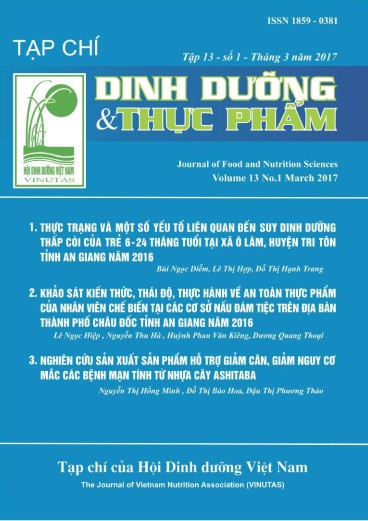NGHIÊN CỨU SẢN XUẤT SẢN PHẨM HỖ TRỢ GIẢM CÂN, GIẢM NGUY CƠ MẮC CÁC BỆNH MẠN TÍNH TỪ NHỰA CÂY ASHITABA
Nội dung chính của bài viết
Tóm tắt
Trong nhựa của cây ashitaba chứa Chalcone – hợp chất màu vàng, có hoạt tính sinh học cao. Hai chalcone chính trong nhựa cây ashitaba là "Xanthoangelol" và "4-Hydroxyderricin”. Chalcone có tác dụng hỗ trợ giảm cân, giảm nguy cơ mắc các bệnh mạn tính không lây. Sản xuất viên nang cứng (500 mg) hỗ trợ giảm cân, giảm nguy cơ mắc các bệnh mạn tính không lây từ nguyên liệu chính là bột nhựa cây Ashitaba (chứa 8% Chalcone) và các Vitamin C, D, E, β-caroten cho đối tượng người trưởng thành, có nguy cơ thừa cân, béo phì, có chỉ số BMI > 23. Sản phẩm có hàm lượng các chất trong một viên: Xanthoangelol: 4 mg; 4-hydroxyderricin: 2,2 mg; Vitamin C: 35 mg; Vitamin D: 200 IU; Vitamin E: 3 mg; β-caroten: 3 mg. Nghiên cứu xác định được công thức premix NIN AO (hỗn hợp vitamin C, D, E, β-caroten), xác định được công thức sản xuất sản phẩm: 16% bột nhựa cây Ashitaba, 42% premix, 39% Lactose khan, 2% Magie Stearat, 1% bột talc và phương thức trộn tối ưu: trộn bột nhựa cây Ashitaba với Lactose khan trước, sau đó trộn với Premix và tá dược trơn.
Từ khóa
Ashitaba, Chalcone, béo phì, bệnh mạn tính
Chi tiết bài viết
Tài liệu tham khảo
2 Nguyễn Công Khẩn, Lê Bạch Mai (2007). Thừa cân - Béo phì và một số yếu tố liên quan ở người trường thành Việt Nam 25 -60 tuổi. NXB Y học 2007.
3 Tatsuji Enoki (2007). Antidiabetic activities of Chalcones Isolated from a Japanese Herb, Angelica Keiskei. Journal of Agricultural and Food Chemistry, 55(15):6013-17.
4 Kyuichi Kawabata (2011). Prenylated Chalcones 4-hydroxyderricin and Xanthoangelol stimulate glucose uptake in skeletal muscle cells by inducing GLUT4
translocation. Molecular nutrition and food research, 55(3):467-75.
5 Hiromu Ohnogi (2012). Efficacy and Safety of Ashitaba (Angelica Keiskei) on the patients and candidates with Metabolic syndrome: A pilot study. Japanese journal of complementary and Alternative Medicine, 9(1):49-55.
6 Aasheim ET, Hofso D, Hjelmesaeth J, Birkeland KI, Bohmer T (2008). Vitamin status in morbidly obese patients: a crosssectional study. Am J Clin Nutr.;87:362–369.
7 Villaca Chaves G, Pereira SE, Saboya CJ, Ramalho A (2008). Nonalcoholic fatty liver disease and its relationship with the nutritional status of vitamin A in individuals with class III obesity. Obes Surg;18:378–385.
8 Viroonudomphol D, Pongpaew P, Tungtrongchitr R, et al (2013). The relationships between anthropometric measurements, serum vitamin A and E concentrations and lipid profiles in overweight and obese subjects. Asia Pac J Clin Nutr.;12:73–79.
9 Vimaleswaran K.S, Berry D.J, Luetal C (2013). Causal relationship between obesity and vitamin D status: bi-directional Mendelian randomization analysis of multiple cohorts. PloS Medicine,vol. 10, no. 2, Article ID e1001383.
10 García O.P, Kurt Z Long and Jorge L Rosado. Impact of micronutrient deficiencies on obesity. Nutrition Reviews, 67 (10): 559 – 772.


